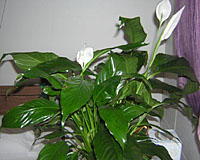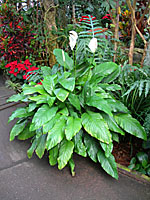Terry L. Ettinger Horticulture Consulting Services
Meeting The Needs Of Today With A Vision For The Future
Question of the Week
Caring for Peace Lilies
 Q. I have a pretty simple question. What is the name of this plant, and how do you take care of it? To me, it looks like some
sort of Jack-in-the-pulpit.
Q. I have a pretty simple question. What is the name of this plant, and how do you take care of it? To me, it looks like some
sort of Jack-in-the-pulpit.
A. You're certainly on the right track! The plant in question, at right, is a peace lily (Spathiphyllum). While more than thirty species of this plant are native to the tropical rainforests of Central and South America, and an additional three species are found in the Philippines and Indonesia, it does belong to the same family (Araceae) as our native Jack-in-the-pulpit (Arisaema triphyllum).
 In
the picture at left, the large, white "hood"-like structure is
called a spathe. Because this spathe looks somewhat like a leaf, or "phyllum" in Greek, the botanist that named this
group of plants combined the two words to give us Spathiphyllum.
In
the picture at left, the large, white "hood"-like structure is
called a spathe. Because this spathe looks somewhat like a leaf, or "phyllum" in Greek, the botanist that named this
group of plants combined the two words to give us Spathiphyllum.
Taking a closer look at this picture, the actual flowers are inside of all the tiny bumps, or flower buds, that are covering the upright stalk, which is called a spadix.
 Alright, with that brief plant anatomy lesson out of the way, let's get down to the business of caring for this plant.
Alright, with that brief plant anatomy lesson out of the way, let's get down to the business of caring for this plant.
Because they grow on the floor of tropical rainforests, it stands to reason that peace lilies grow best where humidity levels are very high - almost misty - all day, every day, such as in the tropical rainforest section of the Lamberton Conservatory in Rochester, New York, at right.
 Unfortunately, in our homes, peace lilies are often placed near drafty windows and heat sources, at left, which they do not like at all!
Unfortunately, in our homes, peace lilies are often placed near drafty windows and heat sources, at left, which they do not like at all!
So, instead, make sure to place your peace lilies where they'll receive as much bright sunlight indoors as possible from September through April - but nowhere near sources of hot, dry air, or cold drafts.
Also, while peace lilies prefer constantly moist soil, they cannot tolerate standing water around their roots. So, if you give or receive a gift plant, make sure to either punch holes in the bottom of any decorative foil covering the pot, or remove the foil completely. After watering your plant - generally every third or fourth day, make sure to empty any standing water in the saucer beneath the pot.
As the days get longer and sunlight gets more intense from May through August, move your peace lily to a spot where it will receive bright, but indirect sunlight. Also, during this time of year when it will be growing faster, you can add quarter-strength houseplant fertilizer to the water you apply every three or four days.
Don't be discouraged if your peace lily doesn't flower profusely. Even under perfect greenhouse conditions, plants rarely produce more than a half dozen flowers at a time - and few or none during the winter months.
When the flowers do fade, simply cut the stems off two or three inches above where they emerge from the base of the plant. And, if necessary, repot large plants in April using a peatmoss-based potting soil, such as Pro-Mix.
One last interesting note (at least to me), is that as recently as 1980, there were only about six different cultivated varieties (cultivars) being grown commercially in the U.S. However, because they're relatively easy to hybridize, propagate and produce commercially, there are now more than fifty different cultivars being grown commercially in the U.S., from miniature forms less than a foot tall and wide, to very large forms that may grow five or six feet tall and wide under ideal conditions!
(Note that the first and last pictures were taken by my dad, Dwayne Ettinger.)